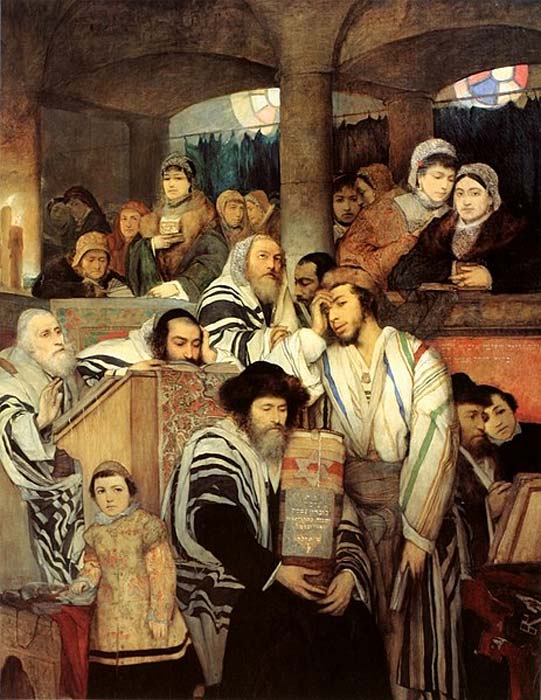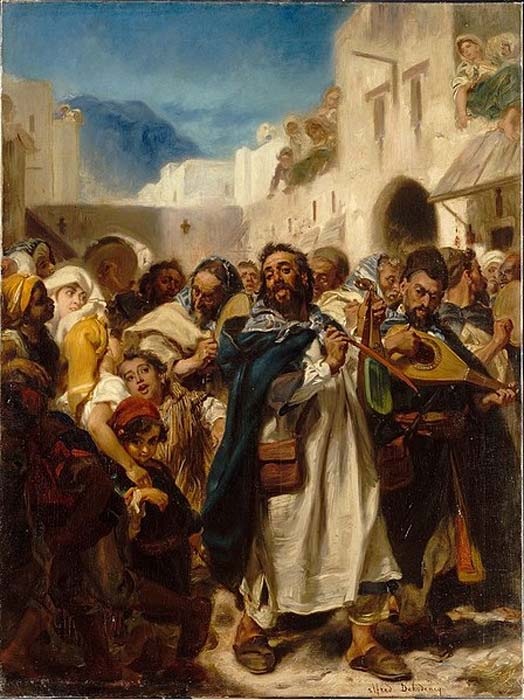
Unity in Diversity: Studies Reveal Surprising Stories for the Genes of Ancient Hindus and Jews
New research using ancient DNA is rewriting the genetic history of two ancient peoples; the Hindus and the Jews - and it shows that their two religious civilizations are the result of multiple ancient ethnic migrations; into the Land of India in the case of the Hindus, and into diaspora Jewish communities in the case of the Jewish people.
First the Hindus. According to Tony Joseph, author of “Early Indians”, Hindu nationalists believe the source of the Indian civilization was a group of people who called themselves Aryans - a nomadic tribe of horse-riding, cattle-rearing warriors and herders who composed Hinduism's oldest religious texts, the Vedas. Aryans, they argue, originated within the Land of India, spreading themselves and their family of Indo-European languages across large parts of Asia and Europe.

West Aryan types of eastern and northern Europe. In the image: Georgians, Ossette, Albanian, Woman of Iceland, Russian woman of Rjasan, Roumanian woman, Poles of Radom. (Public Domain)
The “Out of India” Thesis
Many Indian scholars question the "out of India" thesis, arguing that Indo-European language speakers - or Aryans - were just one of many streams of prehistoric migrants who came into India after the decline of the much earlier Harappan (or Indus Valley) civilization, which thrived in the current area of north-western India and Pakistan around the same time as the early Egyptians and Mesopotamians.
- The True Aryans: Who Were They Really and How Were Their Origins Corrupted?
- Horses, Cows and Celestial Creatures at the Dawn of Civilizations
- Timeline of the Harappan Civilization is Pushed Back 2,500 Years as Researchers Find New Reason for Its Fall

Illustration said to depict an Indo-Aryan person. (No Known Copyright)
Hindu right-wingers believe the Harappan civilization was also an Aryan or Vedic civilization; but none of their languages have been deciphered, so no one knows what language they spoke.
Now studies using ancient DNA are rewriting world history, and there have been many fascinating discoveries - especially for Hindu and Jewish peoples.
The most recent study on this subject, led by geneticist David Reich of Harvard University, who had also studied the genetic evolution of the Jewish people, was published in March 2018 and co-authored by 92 scholars from all over the world - many of them leading names in disciplines as diverse as genetics, history, archaeology, and anthropology.
The study showed that in the last 8,000 years there were two major migrations into, and not out of, India. The first one originated from the Zagros region in south-western Iran (which has the world's first evidence for goat domestication) and brought agriculturists, most likely herders, to India.
This would have been between 6,000 and 3,000 BC. These Zagrosian herders mixed with the earlier inhabitants of the subcontinent - the First Indians, descendants of the Out of Africa (OoA) migrants who had reached India around 65,000 years ago - and together, they created the Harappan civilization.

Diorama of everyday life in Indus Valley Civilization. (National Science Centre, Delhi, India) (Biswarup Ganguly/ CC BY 3.0 )
In the centuries after 2000 BC, came the second set of immigrants (the Aryans) from the Eurasian Steppe lands, probably from Kazakhstan, who brought with them an early version of Sanskrit, mastery over horses, and new cultural and religious practices, all of which formed the basis of early Hindu/Vedic culture.
A Genetic “Indian Pizza”
A thousand years earlier these Aryan peoples from the Eurasian Steppe lands had moved into Europe, mixing with agriculturists there, and spreading Indo-European languages into Europe.
Other genetic studies have brought to light more migrations into India, such as that of the speakers of Austro-Asiatic languages who came from south-eastern Asia. Thus India's population is made up of a number of different layers added at different times.
As Tony Joseph writes in his book “Early Indians’’, the Indian population is like a pizza, with the first Indians forming its base. Though the base is thin in some places and thicker in others, studies show that 50% to 65% of the genetic ancestry of almost all Indians derives from the First Indians.

Mohenjo-daro is an ancient Indus Valley Civilization city built around 2500 BC. (suronin / Adobe Stock)
On top of the base comes the sauce - the Harappans. Then come the various toppings and the cheese - the Austro-Asiatic, Tibeto-Burman and Indo-European language speakers or Aryans, all of whom found their way into the subcontinent later.
Hindu nationalists will not admit that the Aryans were not the first inhabitants of India; and that the Harappan civilization existed long before their arrival, for it would mean acknowledging that Aryans or their Vedic culture were not the singular fountainhead of Indian civilization.
The idea of the mixing of different population groups is even more unappealing to Orthodox Hindus and Hindu nationalists as they put a premium on racial purity. Plus the migration theory puts Aryans on the same footing as latter-day Muslim conquerors of India - such as the Mughals.

Miniature painting by Bitchitr from around 1630 - now at the Chester Beatty Library, Dublin. It depicts three of the most important emperors of the Mughal Period: Akbar is in the center, his son, Jahangir, is to his right, and his grandson, Shah Jahan, is to his left. The painting was commissioned by Shah Jahan, the builder of the Taj Mahal. (Nathan Hughes Hamilton/CC BY 2.0)
Unity in Diversity
Some Hindu nationalists demand that the Harappan civilization be renamed the Saraswati river civilization. Since the Saraswati is mentioned in the Rig Veda, such a renaming would serve to emphasize the link between Harappan civilization and the Aryans.
However, Tony Joseph says the real message that the new research carries is an exciting and hopeful one: that Indians have created a long-lasting civilization from a variety of heredities and histories. The genius of the Indian civilization during its best periods has been inclusion, not exclusion. Unity in diversity is, indeed, the central theme of India's genetic make-up.

Youth wearing Assamese traditional costumes. (Diganta Talukdar/CC BY 4.0) This is one example of a physically diverse group of people in India.
A Biological Basis for Jewishness
Now to the Jewish people. I would say that the same thing can also be said for the Jewish people in the 2500 years since the Babylonian exile. After all, are all present day Jews really the biological descendants of the Jews who inhabited the Land of Israel 3,000 years ago?
Yes and No. A new genetic analysis supports the historical record of Middle Eastern Jews settling in North Africa during Classical Antiquity, actively proselytizing and marrying local populations, and, in the process, forming distinct populations that later stayed largely intact for over 1500 years.

Yemenite Jew blowing shofar, 1947. (Public Domain)
The study was published online August 6, 2012 in the Proceedings of the National Academy of Sciences. "Our new findings define North African Jews, and enhance the case for a biological basis for Jewishness," said study leader Harry Ostrer, M.D., professor of pathology, genetics and pediatrics at Albert Einstein College of Medicine of Yeshiva University.
However, as anyone who has been to present day Israel knows, Jews come in many shades and looks. This is because even in the diaspora, and even against the will of the ruling religious authorities, Jews have quietly welcomed converts into the Jewish community, even against the formal rules of medieval rabbis. That is why most Jews in different geographical locations tend to look similar to the local majority after several generations.

Ashkenazi Jews praying in the Synagogue on Yom Kippur. (1878 painting by Maurycy Gottlieb). (Public Domain)
The rabbinical rule that one should not refer to any Jew's convert status is evidence of the desire of Jewish leaders to keep proselytizing activities secret from the non-Jewish ruling religious authorities.
In a previous genetic analysis, the researchers showed that modern-day Sephardic (Greek and Turkish), Ashkenazi (Eastern European) and Mizrahi (Iranian, Iraqi and Syrian) Jews that originated in Europe and the Middle East are more related to each other than to their contemporary non-Jewish neighbors, with each group forming its own cluster within the larger Jewish population.
Further, each of the four geographical groups’ genes demonstrated Middle-Eastern ancestry plus varying degrees of inclusion of converts to Judaism from the surrounding populations. This is true even though two of the major Jewish populations -- Middle Eastern and European Jews -- were found to have diverged from each other approximately 2,500 years ago.
The current study which extended the analysis to North African Jews, the second largest Jewish Diaspora group, found that they also were more related to each other than to their contemporary non-Jewish North African neighbors.

Sephardi Jew from Algeria, circa 1890. (Public Domain)
Inclusion Not Exclusion
The current study also included members of Jewish communities in Ethiopia, Yemen, and Georgia. In all, the researchers analyzed the genetic make-up of 509 Jews from 15 populations along with genetic data on 114 individuals from seven North African non-Jewish populations.
- Sanauli Find Challenges Aryan Invasion Theory and Could Re-write Indian History
- By the Rivers of Babylon: Life in Ancient Babylon’s Thriving Jewish Community
- Can Jewish People be a Nation, and a Religion, and a Race?
North African Jews exhibited a high degree of endogamy, or marriage within their own religious group in accordance with Jewish custom. Ethiopian and Yemenite Jewish populations also formed distinctive genetically linked clusters, as did Georgian Jews.
So I would also say that the real message that the new genetic research carries is an exciting and hopeful one: that Jews have created a long-lasting civilization from a variety of ethnic and racial heredities and national histories. The genius of the Jewish civilization during its best periods has been inclusion, not exclusion. Unity in diversity is the central theme of the Jewish people’s genetic historical make-up.

Jewish Festival in Tetuan, Alfred Dehodencq, 1865, Paris Museum of Jewish Art and History. (Public Domain)
While the inhabitants of the Indian sub-continent, like those of China, have always outnumbered their conquerors, and thus been able to absorb them; the Jewish diaspora has always been a small minority, so opposition to ‘outreach’ may have been a wise precaution then.
But it is very counter-productive now, when Jews are a majority in Israel. Orthodox unwillingness to increase the number of non-Orthodox Jews by accepting Conservative and Reform converts is planting the seeds for major divisiveness in Israel’s future.
Top Image: ‘Indian Barbers Saharanpore’ by Edwin Lord Weeks. Scientists have recently found just how diverse both Indian and Jewish genes really are. Source: Public Domain
Rabbi Allen S. Maller has published over 300 articles on Jewish values in over two dozen Christian, Jewish, and Muslim magazines and web sites. Rabbi Maller is the author of "Tikunay Nefashot," a High Holy Day Prayer-book, two books of children's short stories, and a popular account of Jewish Mysticism entitled, "God, Sex and Kabbalah." His most recent books are "Judaism and Islam as Synergistic Monotheisms' and "Which Religion Is Right For You? A 21st Century Kuzari”, both available on Amazon.















